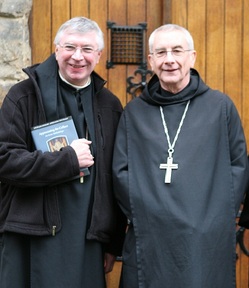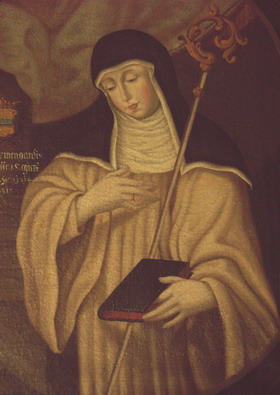Abbot Michael C. Zielinski OSB, undersecretary of the Congregation for Divine Worship, discusses what is being taught by the most recent pontiffs. Abbot Michael notes the continuity and distinctions in celebrating of the sacred Liturgy by Popes Benedict and Pope Francis. But there are some things that Abbot Michael notes that are not liturgical per se, “the spirit” can be a bit vague some ways. Moreover, there are things that are already expected as the result of the theology and upheld by the rubrics. More reflection on what the synthesis and art of celebrating means, teaches and how it sanctifies. Here is a beginning… The Catholic News Service provides the video feed.
Tag: liturgical prayer
Praying for the abbot in the Eucharistic Prayer at Mass?
Frequently do I go to places where certain liturgical practices catch my attention because of the novelty of what is said and heard. We always need a deeper understanding, a profound appreciation for the prayer of the Church as expressed in the sacred Liturgy. Some will say that canon law, particularly liturgical law, is the bad side of the Good News. As Catholics we are part of a Church; as Catholics we are not independent of sacred Scripture, sacred Tradition and the sacred Magisterium; as Catholics we follow a guided companionship on a journey to a deeper communio with the Triune God. We are not Marlboro people; we are, in fact, sheep in flock called to the Holy Synaxis, to the holy in-gathering of a people in Christ, or simply, Church. We have a good shepherd in Jesus and in His successors, that is, the bishops, and we follow the teaching authority of the Christ and His vicars.
This is a long introduction to a question as whether or not priests of monastic communities ought to name the abbot in the Eucharistic Prayer. There seems to be some confusion over this seemingly small, trite matter. It is not small, and it is not trite. We have an ecclesiology, and we have a liturgical practice that ought to be followed because we live our Catholic lives in communion with others. Abbots are minor prelates; they exercise their pastoral authority and power in their monastic community and not in a diocese, and by extension to the dependent priories. An abbot ought not employ the attitude of having a mitre and a crosier so that you can do whatever you’d like, whenever you’d like, etc.
Can a priest commemorate Abbot X (or even the abbess if in the context of a woman’s monastery) along with the pope and the bishop in the Eucharistic Prayer at Mass?
The General Instruction of the Roman Missal gives four titles that may be named in the Eucharistic Prayer: “The Diocesan Bishop, or one who is equivalent to the Diocesan Bishop in law, must be mentioned by means of this formula: together with your servant N., our Pope, and N., our Bishop (or Vicar, Prelate, Prefect, Abbot)” (no. 149). Each of these offices are “equivalent to the Diocesan Bishop in law” by virtue of their appointment to act on behalf of the Supreme Pontiff within a particular area.
Continue reading Praying for the abbot in the Eucharistic Prayer at Mass?
That heaven and earth touch, St Peter’s Omaha guides
I was reading one of my favorite blogs this afternoon, Fr. Z’s Blog (olim: What Does The Prayer Really Say?) and read his post St Peter’s Church in Omaha, NE. As I am curious about many things, especially in the ways the Incarnation is made manifest in parishes, I was stunned with the clarity of the pastor’s clarity, charity, and competence in leading souls. In fact, I watched the video on St Peter’s Church more than once because I had to get it clear in my mind and heart what Father Damian Cook and his collaborators are doing, and in the ways the Holy Spirit has allowed His gifts to be extroverted. There is a distinctive focus on the cultures of prayer, community, study and service which is a wonderful gift. St Peter’s is a place that the proposal of the gospel and the Church come alive.
It is not an exaggeration to say that Father Cook is orchestrating so many good things for Christ and His Church, both universal and in the local Church of Omaha. But let’s be clear: it is not Cook but Christ; it is not the community that’s center, but the Communio of the Trinity. I don’t want to canonize Father Cook but I do want to draw attention to the good being done.
As the Prophet Ezekiel showed us, and more importantly what the Lord did for us in His Resurrection: that it is possible for old bones to be constituted again (and in the Lord’s case, in a glorified body). Father Cook is illustrating how a decaying church community in urban Omaha can become a thriving religious and cultural treasure.
This is a clear and contemporary example of Saint Benedict rebuilding culture, or Saint Francis rebuilding the Church, or Blessed Teresa of Calcutta caring for all people. And the examples are plentiful…
Prophet Habakkuk
 The Byzantine liturgical calendar includes the prophets in its commemorations because they foretell the coming of the Messiah, as the Kontakion states for today. (The Latin Church has the prophets in the Martyrology but does often feasts.) As a liturgical note, kontakion is a poetic text tied to the celebration at hand, or of a particular saint recalled during the Liturgy, most often sung by the deacon or some designated person following the proclamation of the gospel.
The Byzantine liturgical calendar includes the prophets in its commemorations because they foretell the coming of the Messiah, as the Kontakion states for today. (The Latin Church has the prophets in the Martyrology but does often feasts.) As a liturgical note, kontakion is a poetic text tied to the celebration at hand, or of a particular saint recalled during the Liturgy, most often sung by the deacon or some designated person following the proclamation of the gospel.
the world the coming forth of God from the south, from the Virgin. Standing on
the divine watch, you received a report from the radiant angel: “You proclaimed
the Resurrection of Christ to the world!” Therefore in gladness we cry out to
you: “Rejoice, splendid adornment of the prophets!”
Saint Mechtilde of Hackeborn
The Church celebrates two Benedictine friends in several days: Saints Mechtilde and Gertrude. By today’s standards of canonizations, neither were formally canonized by the Church; until recently Hildegard enjoyed a canonization status only observed in Benedictine communities. Her liturgical observance is recognized more universally today. Pope Benedict XVI spoke eloquently of Saint Mechtilde of Hackeborn at a 2010 Wednesday Office. The Pope gives a superb insight into the person of Saint Mechtilde that is extraordinarily helpful.
Not daring to ask
The opening Collect for the Mass of the 27th Sunday through the Year is startling. The prayer is really breath-taking. Did you notice the same line I did when it was prayed by the priest today? Here is what the Church gave the priest to pray:
- the address of God: “Almighty and ever-living”
- the “ut clause”: “who in the abundance of your kindness surpass the merits and the desires of those who entreat you”
- the petition: “pour out your mercy upon us to pardon what conscience dreads and to give what prayer does not dare to ask”
The Exaltation of the Holy Cross
 We should glory in the Cross of our Lord Jesus Christ, in whom is our salvation, life and resurrection, through whom we are saved and delivered. (antiphon)
We should glory in the Cross of our Lord Jesus Christ, in whom is our salvation, life and resurrection, through whom we are saved and delivered. (antiphon)
Give your “Amen” to God’s glory
In our continuing reflection on prayer in the letters of Saint Paul, we now consider the Apostle’s striking affirmation that Jesus Christ is God’s “Yes” to mankind and the fulfillment of all his promises, and that through Jesus we say our “Amen”, to the glory of God (cf. 2 Cor 1:19-20). For Paul, prayer is above all God’s gift, grounded in his faithful love which was fully revealed in the sending of his Son and the gift of the Holy Spirit. The Spirit, poured forth into our hearts, leads us to the Father, constantly making present God’s “Yes” to us in Christ and in turn enabling us to say our “”Yes” – Amen! – to God. Our use of the word “Amen”, rooted in the ancient liturgical prayer of Israel and then taken up by the early Church, expresses our firm faith in God’s word and our hope in his promises. Through this daily “Yes” which concludes our personal and communal prayer, we echo Jesus’ obedience to the Father’s will and, through the gift of the Spirit, are enabled to live a new and transformed life in union with the Lord.
Pope Benedict XVI
30 May 2012

